Finding out why basil turns yellow and eliminating the problem effectively
Basil is an aromatic spice that is a must-have in many Italian dishes. It is combined with meat and vegetables, it is even added to desserts and sugary drinks. It is possible to grow such a grass in the climatic conditions of our country both in the open field and at home, in a pot on a windowsill.
Basil is very unpretentious. It does not require much attention from the gardener, but it is still worth following the basic rules of care, protecting the plant from diseases and pests. Otherwise, you may encounter a problem such as yellowing of the leaves. Find out why this happens from the article.
The content of the article
Why does basil turn yellow
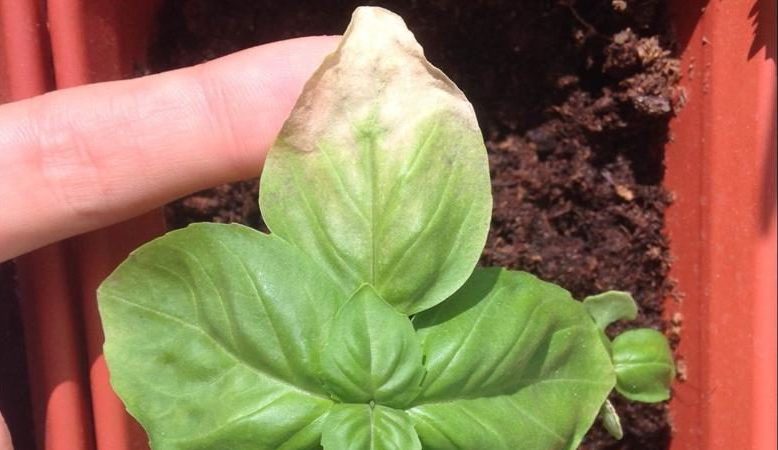
Basil leaves are green or purple depending on the species.... If they began to turn yellow, wither, dry up and fall off, then the plant is in uncomfortable conditions. The reason may lie in improper care, infection with diseases and pests, a lack of nutrients.
The signs that accompany the discoloration of the leaves will help determine why basil turns yellow.
Diseases
The most common reason why basil dies when receiving quality care, - infection with infections. The fragrant seasoning affects several types of diseases.
Blackleg
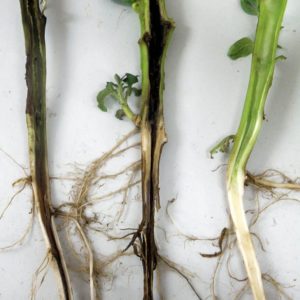
Blackleg is a fungal disease that often affects young plants. Basil growing in a greenhouse or on a windowsill has the highest risk of infection.
The infection affects the root peduncle of the seedlings, blocking the vessels that carry water and nutrients to the plant cells. Fungi also secrete enzymes that cause tissue decomposition. Because of this, the basil does not receive nutrition.
The disease is accompanied by the following symptoms:
- The base of the stem darkens, becomes soft, the seedlings droop.
- The leaves become thinner, brighter, fall off.
- The plant dies.
The black leg is not treatable, so it is important to eliminate the causes leading to its development in advance:
- Stagnant moisture. It occurs due to excessive watering or lack of holes and drainage layer in the pot. Excessive soil moisture is the optimal condition for the development of a fungal infection.
- Poor soil aeration. It occurs if the upper layers of the soil solidify, cease to let air through. To break up the earth crust, the soil is loosened after each watering.
- Increased acidity of the soil... The plant loves neutral or slightly acidic soil.
If a blackleg has hit several plants in a box with seedlings, you will have to throw out all the specimens growing in the same container. When infected in a greenhouse or open field, only damaged specimens are excavated. The soil is treated with a light pink solution of potassium permanganate or copper sulfate.
Note! Purple basil is more disease resistant than green.
Gray rot
Gray rot is also a fungal disease. It often infects plants in the greenhouse and at home.
Disease symptoms:
- Brown, gray and yellowish spots appear on leaves that are near the ground. They are still dry at this stage.
- After a while, the spots begin to get wet. A gray coating forms on them.
- The disease spreads up the bush, affecting all the leaves.
- The plant withers, acquires an unnatural yellowish tint, and dies.
They fight the disease with the help of fungicides, biological agents, folk remedies.
Fusarium
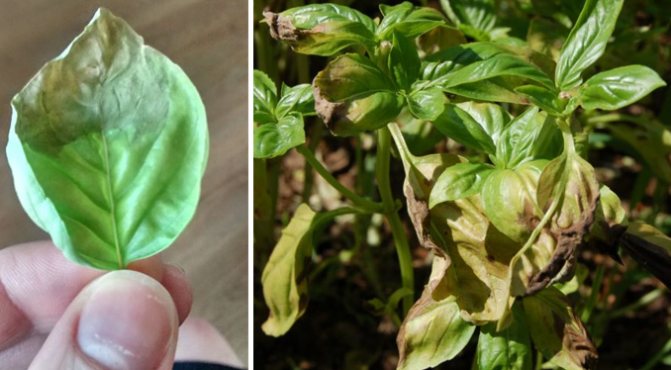
Gray rot is another fungal disease that can kill basil... The pathogen releases toxins that affect the plant vascular system.
The disease develops in warm weather with high humidity. Fungal spores are contained in the soil in a dormant state. Under favorable conditions, they wake up, begin to multiply actively, and move to the plant.
Fusarium symptoms:
- The leaves of adult plants become thinner, turn pale, turn yellow. Black and yellow-brown dots appear on them. The upper part of the bush begins to dry out, the plant disappears.
- The foliage of a young basil becomes thinner, acquiring a purple hue. Black and dark yellow dots appear on it. Basil dries and dies.
In the early stages of the disease, Fusarium is treatable. If the disease is started, the basil will die, it will not be possible to save it.
Fungicides, for example, "Impact" or "Merpan", effectively cope with fungal diseases. However, chemicals penetrate the structure of the leaves, reducing the environmental friendliness of the product.
Greens absorb harmful substances more than other plants, so most gardeners are trying to abandon chemicals. They can be replaced with biological drugs, for example, "Fitosporin". The product contains microorganisms that destroy harmful fungi. Such preparations are less harmful to the environment than fungicides and are safe for humans.
The safest option is folk remedies. They are used immediately after the first symptoms are detected. In advanced cases, they are ineffective.
Experienced gardeners fight fusarium with onion broth. For its preparation, take 1 part of the onion husk and pour 4 parts of boiling water. The tool is insisted for 2 days, then filtered. The plants are sprayed with the solution every 5 days.
Pests
Another reason why basil wilted and turned yellow may be pests.
Aphid
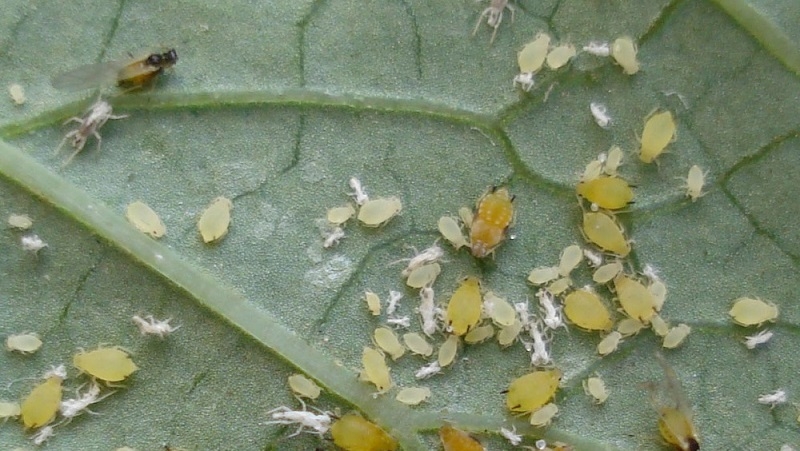
Aphids are small sucking insects that colonize the basilica. The pest has a translucent body of yellow, gray, green or brown color and a soft chitinous cover. The pest sucks sap from plants, leading to their death.
Aphids on the basilica are easy to spot. If you look closely at the bush, you can see many small insects on it, some of which have wings.
When aphids are affected, basil leaves turn pale, turn yellow, curl and dry out, and then fall off... Often a dark coating appears on them. This is a sooty fungus that develops on the sugary waste products of the pest.
Folk remedies are effective against aphids: infusions of bitter pepper, dandelion, tomato tops, wormwood, onion and garlic husks. The selected plants fill the bucket by a third, the rest of the volume is poured with boiling water. The agent is insisted for a day, then filtered and used for spraying.
Another proven option is a tar soap solution... Rub a bar of soap and dissolve it in a bucket of water. The product is used for spraying.
Spider mite
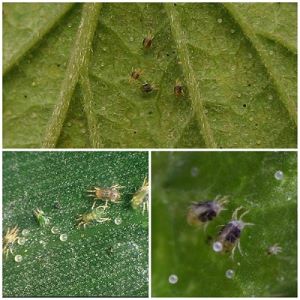
Spider mites are small pests of red, black, green or brown color. It actively reproduces in warm and dry air. It feeds on plant sap.
When basil is affected by a tick, the leaves turn yellow, thinner, droop, then dry up and fall off. The pest can be detected by cobwebs and black dots on the underside of the leaves.
To combat spider mites, use the same means as for removing aphids. Insecticides are also effective.
Snails and slugs
Slugs and snails feed on basil leaves. In this case, not only holes appear on the plant, but also yellow dry areas. The pests are large, so you can see them with the naked eye.
To get rid of the problem, you need to find snail nests and destroy them. Next, the plants are sprayed with a solution of ammonia.To prepare it, dissolve a bubble of ammonia in a bucket of water.
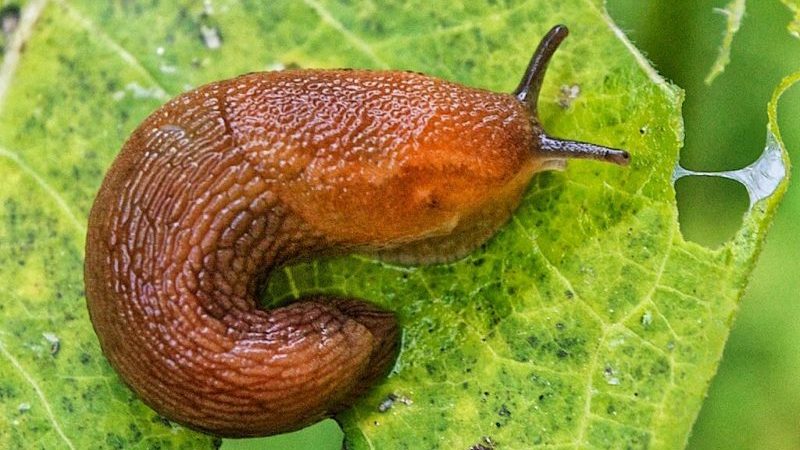
Bedbugs
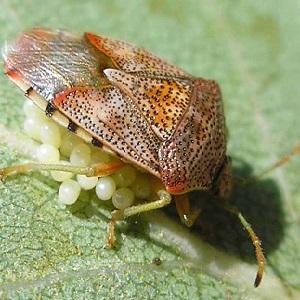
Bed bugs are rounded insects of green, black, red or yellowish color. The pest sucks juices from the plant.
The leaves affected by the bug shrink, deform. In the place to which the insect was attached, yellowish spots appear. Basil becomes lethargic, gradually dies.
1 kg of ash is diluted with 2 liters of water and boiled for half an hour. The resulting mixture is diluted with 10 L of cold water. The agent is sprayed with plants affected by bugs. If this does not help, use the insecticides "Bankol", "Actellik".
Care errors
If the basil turns yellow and leaves the leaves down, the problem may lie in improper care:
- Waterlogging of the soil. Excessive watering and fluid stagnation leads to rotting of the root system. Because of this, the plant ceases to receive nutrients, turns yellow and withers. The most common problem when growing basil in pots without holes and no drainage layer.
- Lack of watering. Basil is a moisture-loving plant. When the soil dries up, it begins to dry out, dies.
- Poor air circulation. After irrigation and precipitation, an earthen crust forms on the soil surface. It does not allow air to flow to the root system, moisture does not evaporate. This leads to damage and decay of the roots, the development of diseases.
- Thickened planting. With too dense plantings or spreading bushes, basil does not receive enough sunlight, it turns pale. In pots, thickened seedlings are stretched out, acquiring a yellowish tint. Also, if there is a lack of space, air circulation is disrupted, which increases the likelihood of infection of plants with a fungus.
- Lack of sunlight. Basil is a light-loving culture. In the shade, he begins to turn pale, becomes stale.
- Exposure to direct sunlight. When exposed to direct sunlight, yellow-brown spots appear on the basil - sunburn.
- Unsuitable soil. The plant turns yellow and dies in acidic, saline and poor soils.
- Weeds. They draw nutrients from the soil, the basil turns pale, becomes stunted, dries up.
- Hypothermia. The problem arises if the plant is on the windowsill in a draft, the seedlings have been transplanted in open groundt without preliminary hardening, basil was poured with ice water (in this case, the roots begin to rot).
- Damage to the root system... In this case, the whole bush turns yellow and dies evenly. You can damage the roots by loosening, weeding or using too concentrated dressings.
- Phosphorus deficiency. The leaves become yellowish, covered with red-blue spots.
- Nitrogen deficiency. In this case, only the tops of the leaf plates become yellow. The growth of new greenery stops.
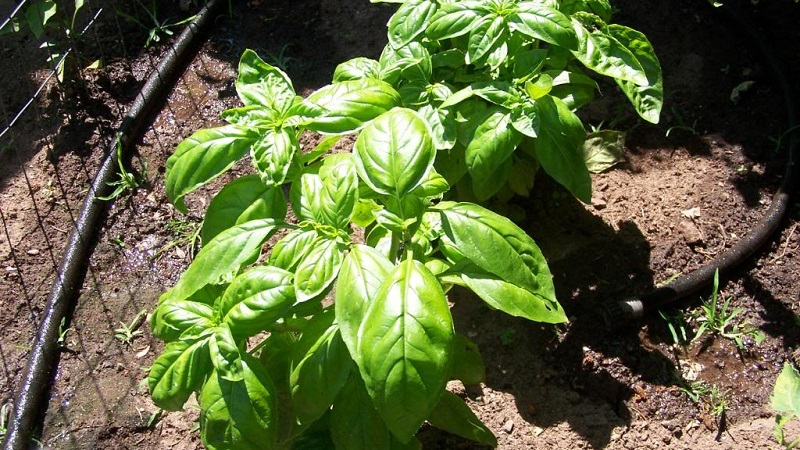
What to do if basil turns yellow, how to save it
To save the yellowed basil, it is first examined for symptoms of disease and pests.... Particular attention is paid to the underside of the leaves, on which the concentration of insects is often found.
In the presence of pests and diseases, treatment is carried out. The composition is used to treat not only the affected plants, but also the neighboring ones, as well as the land in the garden. The most damaged parts and bushes are removed.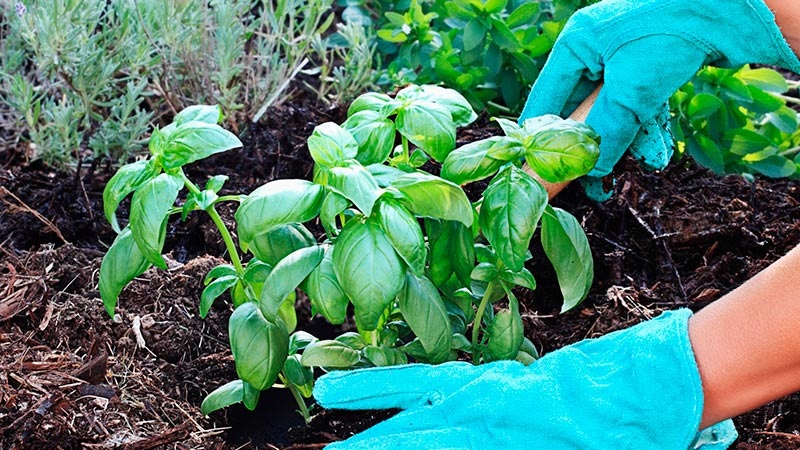
If there are no signs of infection, care should be reviewed. If the soil is dry, the beds are watered; if it is waterlogged, allow it to dry out, scoop up a little earth to the stem to stimulate the development of new adventitious roots.
Fertilization is often necessary. Choose products that contain phosphorus and nitrogen. If the problem is running, it is worth using a growth stimulant, for example, "Epin".
If the plant is in the shade, it is rearranged on a southern windowsill or a fluorescent lamp is used. In the garden, the shaded area will have to be cleared.
Hypothermia and damage to the root system is treated by fertilizing, hilling bushes, watering the soil with a weak solution of potassium permanganate. Be sure to loosen the soil around the plants.
What to do if it dries
The plant dries up due to the defeat of aphids, spider mites, fusarium. Insufficient watering or damage to the root system also becomes the cause of the problem.
If most of the bush is withered, the plant cannot be saved. If a problem has just arisen, basil is watered with a solution of a rooting stimulator and a light pink solution of potassium permanganate. It is important to ensure that the basil gets enough sunlight during the recovery period.
If the basil seedlings turn yellow and fall
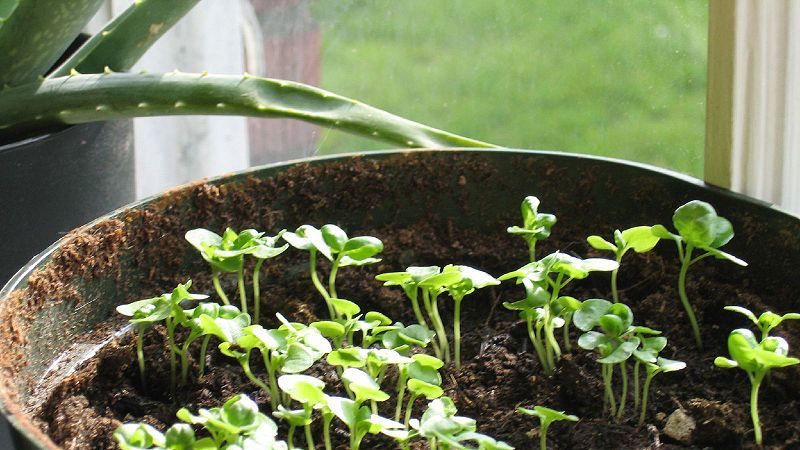
If the basil has risen and immediately falls, and black spots are visible at the base, it means that it was struck by a black leg. In this case, the earth is sprinkled with ash and allowed to dry.... The soil and plants are treated with fungicides.
Treatment does not always help. In case of failure, the affected basil is dug up, removed from the site and burned.
Seedlings fall off if their stems are strongly elongated. To remedy the situation, the plants need to be planted in individual pots, watered with a rooting stimulator ("Solution"), and rearranged in a bright and warm place.
Note! Basil seeds can sprout together with shells that lead to yellowing and death of the shoots. To get rid of the problem, the seedlings are sprayed with warm water every 5 hours until the peel of the seeds falls off.
Preventive measures
The yellowing of basil is easier to prevent than to cure, so it is important to follow the basic rules of prevention:
- Disinfection. Before planting basil soil and seeds are treated with a solution of potassium permanganate or copper sulfate. It is recommended to additionally calcine the soil in the oven. All garden tools are disinfected before use.
- Loosening. The soil is loosened after each watering and precipitation. Be sure to remove weeds from the garden.
- Fertilization. Plants are fed every 2 weeks. Mineral and organic compounds alternate. Before fertilizing, the beds are watered abundantly.
- Correct irrigation regime... Moisten the basil as the soil dries completely. The procedure is performed early in the morning or after sunset. The water should be at room temperature.
- Soil mulching... It is recommended to cover the beds with a layer of mulch (straw, hay, humus). This will help improve air circulation, prevent moisture stagnation, and avoid damage to the plant by diseases and pests.
- Digging the soil before planting. Before planting the basil, the soil is dug to the depth of the shovel bayonet.
- Compliance with crop rotation... Basil should not be planted in the same place for several years in a row. The best predecessors are legumes like lupine.
Conclusion
The yellowing of the basil leaves indicates that the plant will soon die. The reason lies in improper care, damage by fungal infections or pests. In most cases, basil can be saved if you help it in a timely manner.